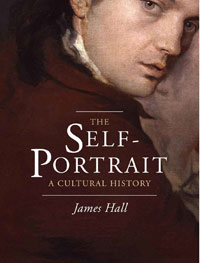Book Review: The Self-Portrait: A Cultural History
Author James Hall’s Book About Selfies
In the Age of Selfies, a book about the history of self-portraiture in the fine arts would seem inevitable. Indeed, much of the PR material that comes with this substantial and beautifully printed book refers to our current craze for digitally memorializing ourselves. And yet the self-portraits by famous artists on which James Hall focuses are far more “composed” than the casual photos we take with our phones.
Snapping a selfie may, for people of a certain generation, feel like the most natural thing in the world, but Hall makes clear that the rage to capture an image of one’s own face is a relatively recent human phenomena: “While Greece and especially Rome offer plenty of examples of portraiture — in coins, medals and busts — self-portraiture is conspicuous by its near total absence.” It is not until the illustrated books of the Middle Ages that artists began making identifiably individual self-images, and only in the Renaissance, with its “Craze for Mirrors,” did painters consistently begin to see themselves as worthy subjects for their own art.

The book is at its strongest when Hall discusses artists famed for their self-portraits. There is Dürer, on the one hand, with his long hair and expressive hands, whose work implies “he is a Christ-like figure, with divine powers of creation.” At the other end of the spectrum is Caravaggio, a heavy drinker and occasional criminal, whose “self-portrayal was an occasion for self-incrimination, and an assertion of his own unheroic status.”
Not surprisingly, Hall devotes the most pages to Rembrandt, whose “self-portraits created his fame as much as they reflected it … inserting the artist into the roll call of great artists.” Rembrandt’s self-portraits have some of the qualities of both Dürer and Caravaggio. Rembrandt envisions himself as a suitable foundation for myth making, but he can also be a subject for pity, if not outright derision, particularly in his old age.
The Self-Portrait also contains interesting sections on Goya and Van Gogh, but it is less interesting the closer it gets to the selfies of camera phones. Hall contends that self-portraiture in the 20th and early 21st centuries “has been many things, but its most distinctive quality is its tendency to conceal or suppress the face and head …. Masks, mask-like faces and masquerade are a typical trademark of the modern self-portrait.” Unfortunately, with the notable exception of a passage on Frida Kahlo, this “shift in focus away from the face” makes for a disappointing final chapter. Oddly, the book ends with no real summing up of self-portraits or any significant thoughts on what form they might take in the future.
This is especially disappointing because the introduction claims “Self-portraiture has become the defining visual genre of our age: the sheer volume of contemporary self-portraits defies enumeration.” Certainly the BP Portrait Awards shown annually in London’s National Portrait Gallery always include a number of strikingly painted selfies. And surely there are many volumes yet to be written about those awkward yet revealing digital images we take of ourselves.
Nevertheless, The Self-Portraitis as good as its subtitle. Hall intelligently and succinctly analyzes centuries of cultural history, and if the book doesn’t much suggest where we’re going, it does an exceptional job of pointing out where we’ve been.



